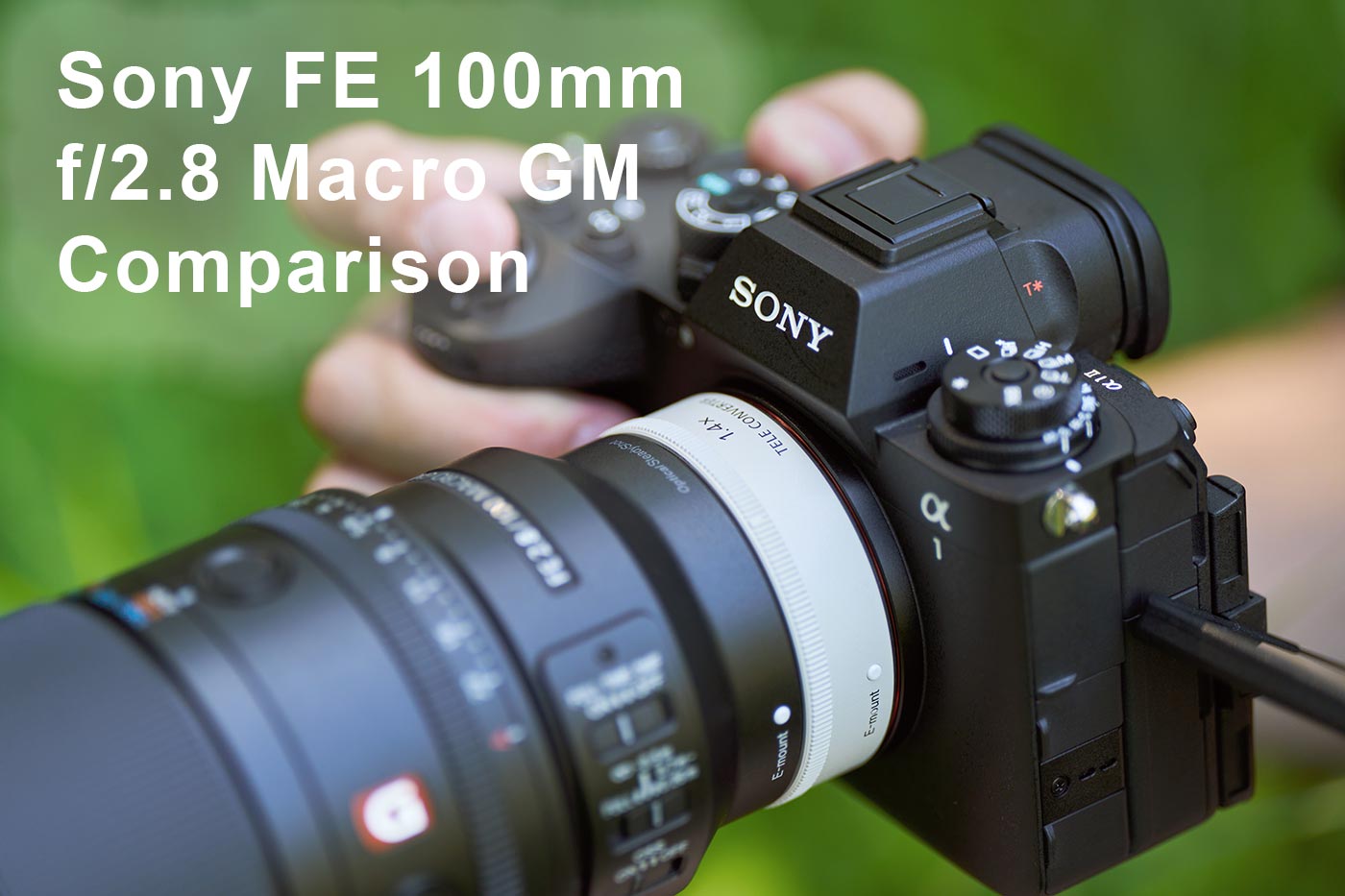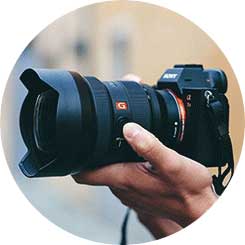- Call us: 01444 237070
- Contact Us
- Stores
- Sign In / Register
-
- Back
- Used Cameras
- Used Accessories
- Used Lenses
- Used Video
- Used Film Equipment
- Used Stock Alert
- Used Blank Test
- Sell or Part Exchange
- Used Clearance
- Recently Added Used Equipment
- Park Picks
- All Used Black Friday Deals
- Faulty
- Trade-In
- Blog
- New in
- Call us
- Contact us
- Stores
- Sign in
- Categories
- Tips & Inspiration
- Reviews
- News
- Events
- Features
- Buying Guides
- Competitions
Sony FE 100mm f/2.8 Macro GM Comparison
With the release of the Sony FE 100mm f/2.8 Macro GM OSS, there are now a handful of native options for Sony E-mount creators looking to capture close-ups. But how does the new 100mm version differ from previous models, and which should you choose if you’re looking for the perfect Sony macro lens for yourself?
Gareth's Favourite Macro Lens? | Sony 100mm f/2.8 GM Macro Lens Video Review
Watch Gareth's hands-on video here.
Discover everything you need to know in our Sony FE 100mm f/2.8 Macro GM comparison, where we compare specs between the Sony 90mm Macro vs the new 100mm f/2.8 Macro, and the recently released 70-200mm f/4 Macro. With two G series and one G Master, all priced very differently, which is perfect for your needs?
Grab a cuppa and let’s find out, starting with the newest member of the prestigious G Master line-up…

Sony FE 100mm f/2.8 Macro GM Price and Release Date
With a launch price of £1399.00 the Sony FE 100mm f/2.8 Macro GM lens sits right in the middle of the three options in this review. It was announced on 30 September 2025, two years after the second-generation Sony FE 70-200mm f/4 G OSS II, and a lengthy 10 years after the 90mm Macro.
While there are several excellent alternatives from Sigma, Voigtländer, Tamron and other brands, for this review we are focusing solely on Sony’s own telephoto lenses. So, let’s start by taking a closer look at the new 100mm Macro, which is the only G Master in this trio, giving it a natural advantage in a specs comparison on paper.

Sample 1 © Peter Sabol. Taken with the Sony A1 II + 2x teleconverter @200mm. Camera settings: 1/30 sec. f/8. ISO 125
Top 10 features
Although this is a prime Sony E macro lens rather than a zoom, it features a complex design that combines special lens elements with the latest optical coatings. It is also weather-sealed and incorporates virtually all of Sony’s most advanced lens technology.
The top 10 features you need to know about include:
- Native 1.4x magnification
- Up to 2.8x magnification with the optional 2.0x teleconverter
- G Master optics with XA and ED glass
- Advanced Nano AR Coating II and Fluorine coating
- 11-blade circular aperture
- Sony’s XD Linear Motor system
- Built-in Optical SteadyShot stabilisation
- Internal floating focus design with Full-time DMF
- Weather-sealed with a compact 67mm filter thread
- 646g weight, measuring 81.4 x 147.9mm
This list sets the stage as the latest close-up lens sounds really impressive, but how does it compare to the other two we’re looking at? Let’s find out next.

Sample 2 © Kyle van Bavel. Taken with the Sony A7R V. Camera settings: 1/3200 sec. f/5.6. ISO 400
Which Sony Macro Lens is Right for you?
To help decide which Sony macro lens you should buy, we’ve compared the Sony FE 100mm f/2.8 Macro GM OSS, vs the FE 90mm Macro G OSS, and the FE 70-200mm f/4 Macro G OSS II. This specs comparison highlights key differences in magnification, optics, handling, and price.
|
|
100mm f/2.8 GM (new) |
||
|
Format |
35mm full-frame |
35mm full-frame |
35mm full-frame |
|
Lens construction |
13 groups, 17 elements |
11 groups, 15 elements |
13 groups, 19 elements |
|
Special elements |
2 ED glass, 2 XA (extreme aspherical) |
1x ED, 1x Super ED, 1 aspherical element. |
1x AA, 1x aspherical, 1x Super ED, 3x ED |
|
Coatings |
Nano AR Coating II, fluorine front element |
Mutlicoated |
fluorine front element |
|
Maximum aperture |
f/2.8 |
f/2.8 |
f/4 |
|
Minimum aperture |
f/22 |
f/22 |
f/22 |
|
Aperture blades |
11, circular |
9, circular |
9, circular |
|
Minimum focus distance |
0.26m |
0.28m |
0.26m (wide) and 0.42m (tele) |
|
Maximum magnification |
1.4x (native) 2.8x with 2.0x teleconverter |
1.0x native |
0.5x native 1.0x with 2.0x teleconverter |
|
Teleconverter compatibility |
SEL14TC (1.4x) SEL20TC (2.0x) |
Not compatible |
SEL14TC (1.4x) SEL20TC (2.0x) |
|
Filter diameter |
67mm |
62mm |
72mm |
|
Image stabilisation |
Optical SteadyShot (OSS) |
Optical SteadyShot (OSS) |
Optical SteadyShot (OSS) |
|
Autofocus actuator |
XD Linear Motor |
DDSSM (Direct Drive Super Sonic wave Motor) |
Four XD linear focus motors |
|
AF speed |
4K/120p |
N/A |
4K/120p |
|
Manual focus features |
Full-time DMF, Linear Response MF |
Fast auto/manual focus switching |
Full-time DMF, Linear Response MF |
|
Dimensions |
81.4 x 147.9mm |
79 x 130.5mm |
82.2 x 149.0mm |
|
Weather sealing |
Yes |
Yes |
Yes |
|
Weight |
646g |
602g |
794g |
|
Price |
£1399.00 |
£819.00 |
£1,649.00 |
Virtually everything about the newer 100mm f/2.8 Macro GM OSS has been updated, from the linear focus motor to the optics and the aperture unit. It clearly achieves higher magnification, with its 1.4x native maximum, extendable to 2.8x with the 2.0x teleconverter.
The 90mm Macro is a strong, more affordable option at £819.00, with true 1:1 magnification and a lightweight design, especially with the pump action manual focus clutch, but it lacks teleconverter compatibility. The 70–200mm f/4 Macro G OSS II provides the versatility of a zoom with 0.5x magnification across its range, though it is larger, heavier, and more expensive.

Sample 3 © Kyle van Bavel. Taken with the Sony A7R V. Camera settings: 1/640 sec. f/5.6. ISO 1000
Handling and ergonomics
Despite being a dedicated macro with a GM optical design, the 100mm f/2.8 GM is surprisingly manageable for everyday use. At 646g it sits very well on full-frame bodies like the A7 IV and A1 II, and even on smaller cameras such as the A7C II.
A 67mm filter thread means you can use common filters without investing in larger, heavier options, which is always welcome. Lens barrel controls include a focus limiter, AF/MF switch, customisable focus hold button, and an aperture ring with click/de-click control, which is another benefit for hybrid stills and video creators.
Creative possibilities
The most notable feature of this lens is its native 1.4x magnification, which reveals details you would typically miss with the naked eye in everyday subjects such as insects, jewellery, and plants. When paired with a 2.0x teleconverter, it achieves a remarkable 2.8x reproduction ratio, opening up opportunities for even more creative, and almost scientific, photography. For video creators, the smooth, rounded bokeh, excellent subject separation, and stabilised focusing all help add cinematic value to close-up shots.
You can, of course, capture portraits with this focal length, which is close to the classic 85mm, albeit with a slightly narrower aperture than you might expect from a dedicated portrait lens. However, the additional 15mm provides an even shallower depth of field when there is good background separation, allowing for beautifully smooth defocus and subject separation.

Sample 4 © Peter Sabol. Taken with the Sony A1 II + 2x teleconverter @200mm. Camera settings: 1/100 sec. f/9. ISO 1600
Which Sony macro should you choose?
Picking the best Sony lens for macro photography is tricky, even when you only look at these three options. Each one has its strengths, so the right choice comes down to how and what you shoot.
The 90mm Macro is the most affordable way into Sony’s dedicated macro line-up. It gives true 1:1 magnification, stabilisation is built in, and it offers a classic focal length that works well for handheld shots of flowers, insects, or everyday close-ups.
The 100mm Macro benefits from a high 1.4x native magnification, which increases to 2.8x with a 2x Sony teleconverter. That makes it more of a specialist lens for extremely fine detail, whether that’s product photography, textures, or anything that benefits from high reproduction ratios. It also keeps pace with hybrid shooting, thanks to fast, quiet autofocus and effective stabilisation, amongst other features.
The 70-200mm f/4 Macro is arguably the most versatile of the three. It has half life-sized reproduction with 0.5x magnification across the zoom range, which is ideal if you want to switch between close-ups and longer telephoto shots in the field. The trade-off is its slower f/4 aperture and a slightly larger body, but for some situations that flexibility will definitely outweigh the compromises. While not a dedicated macro as the other two, it does reach 1x magnification with a teleconverter.
While we’re waiting for a full review on the new model, you can find out more about the existing ones in our reviews, here for the Sony FE 70-200mm f/4 G OSS II lens review and we have a 90mm macro review as well.
The Sony FE 100mm f/2.8 Macro GM OSS is a professional macro lens that delivers extraordinary close-up details along with G Master optical characteristics, which are ideal for close-ups and more.
Order your Sony FE 100mm f/2.8 Macro GM OSS lens today, and get an instant free trade-in quote to offset the cost by selling us your unwanted gear.
Share this post:
By Nick Dautlich on 30/09/2025
Nick Dautlich
Senior Content Writer and Product Reviewer
Nick Dautlich is the Senior Content Writer and Product Reviewer at Park Cameras, with over 15 years of photography experience. A Sony Imaging Professional and expert reviewer, Nick has worked with major brands such as Canon, Sony and Nikon. His work is also featured on Vanguard World UK’s website, Capture Landscapes, and Shutter Evolve. Nick’s photography includes National Trust projects and magazine covers and he is passionate about landscapes and storytelling. Nick also enjoys hiking and teaching his children about nature. Learn more on his profile page.

Trade in your old equipment
Fast and easy trade in service ensures your old gear is collected efficiently and you are paid quickly! It's very simple to trade in your unwanted photography gear. Just head over to our dedicated Sell or Part Exchange page, fill out the details, and we'll get back to you with an offer for your old gear. Take the cash, or put it towards the cost of your new gear. It's up to you! Find out more
sign up to the newsletter
Keep up to date on the latest photography news, events and offers. Sign up now